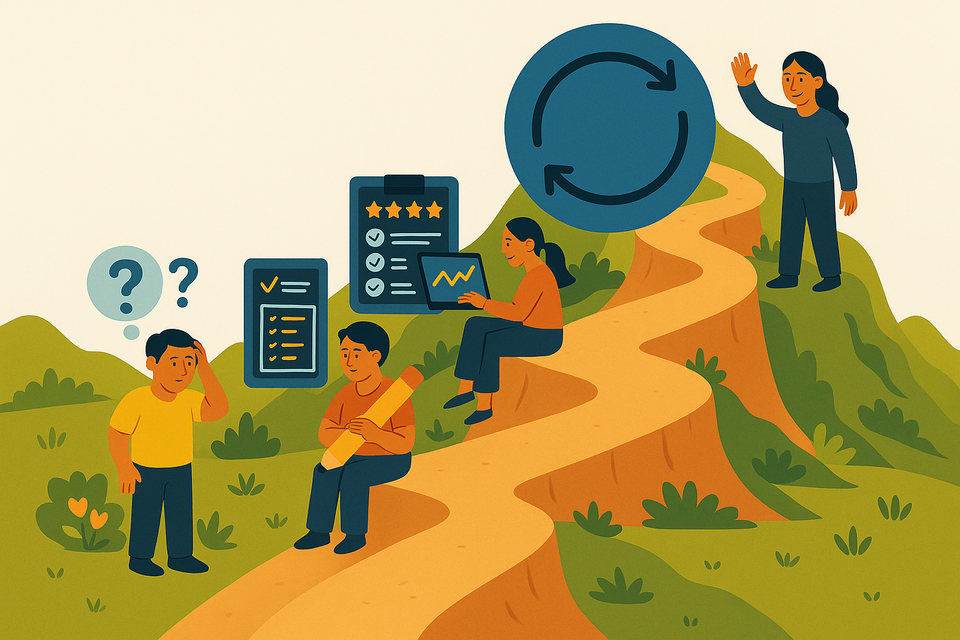From Vibes to Flywheel: Rigorous AI Evaluation
A starter guide to understanding why evals matter, when and how to use them, and how to build a roadmap to a mature eval driven development cycle

I'll help you build a comprehensive case study based on the attached content about evals. Let me first analyze the content and then structure a compelling narrative that walks potential clients through the eval-driven development process.
Case Study: "From Vibes to Flywheel: Building Trust in AI Systems Through Rigorous Evaluation"
Executive Summary
This case study explores how evaluation frameworks (evals) serve as a critical foundation for developing reliable AI systems, especially in high-stakes scenarios. We'll examine how proper evaluation practices reduce risk, ensure alignment with business objectives, and create a continuous improvement cycle that transforms ad-hoc development into systematic, measurable progress.
The Challenge: Moving Beyond "Vibes-Based" AI Development
Many organizations struggle with implementing AI solutions that consistently deliver reliable results. Their development processes often look like:
- Ad-hoc changes based on subjective impressions
- No clear metrics for success
- Difficulty scaling solutions beyond proof-of-concept
- Lack of confidence when deploying to production
- Uncertainty about whether the model is actually doing what it's supposed to
Solution: Eval-Driven Development
Just as Test-Driven Development (TDD) revolutionized software engineering, Eval-Driven Development provides a framework that helps maintain alignment between AI systems and business objectives as you iterate. This case study will walk through how we implemented this approach for a client in the [financial services/healthcare/legal] sector.
The Process
Phase 1: Define the Problem
Before diving into development, we helped the client clearly define:
- The specific inputs and outputs required
- Information about the system architecture
For our client, this meant identifying that they needed:
- Input: [Client-specific example]
- Output: [Client-specific example]
- Architecture considerations: [Client-specific example]
Phase 2: Establish Evaluation Criteria
Working with stakeholders, we defined what "good" looked like:
- Set specific performance goals based on business requirements
- Considered the risk profile and ROI calculations specific to their use case
- Established intermediate goals, including potential human-in-the-loop processes
- Identified protective guardrails to prevent failures
For this project, success meant:
- [Specific metrics tied to business outcomes]
- Error rates below [X%]
- Response times under [Y seconds]
Phase 3: Build a Representative Evaluation Dataset
We created an evaluation dataset that:
- Represented the diversity of production data
- Contained a gradient of difficulty (10% very easy cases, 10% extremely challenging edge cases)
- Included human-reviewed labels
Since the client had limited examples available, we:
- Created synthetic data through carefully designed prompts
- Ensured the synthetic data included hard test cases
- Had domain experts human-label the synthetic data
We started with 50 data points as our baseline evaluation set, then expanded as needed.
Phase 4: Implement Evaluation Types
We implemented a combination of evaluation approaches:
-
Deterministic evals: Simple code-based evaluations including substring matching, direct matches, JSON schema validation, and n-gram overlaps. These provided reliable, cost-effective baseline measurements.
-
Model-graded evals: For aspects requiring judgment, such as:
- Determining if answers came from provided context or were hallucinated
- Assessing answer relevance to queries
- Evaluating subjective qualities
-
Human evaluations: For matters of taste, quality assessment, and highly subjective criteria
Phase 5: Optimize Performance
With our evaluation framework in place, we systematically improved the system through:
- Iterative prompt engineering
- Implementation of advanced techniques (chain-of-thought reasoning, tools, RAG, etc.)
Phase 6: Implementation of the Flywheel
To achieve the highest level of eval maturity, we implemented:
- Automated, high-coverage evaluations
- Deployment with tracing/measurement against live traffic
- Use of production data to track error cases and build guardrails
Key Insights and Best Practices
Throughout this project, we leveraged several best practices:
-
Using advanced reasoning models like Claude Opus (o1) to:
- Accelerate evaluation development
- Create synthetic datasets with appropriate difficulty curves
- Draft output labels for human review
- Feed error modes back into the prompt
-
Utilizing out-of-the-box evaluation libraries for:
- Hallucination detection
- Toxicity screening
- Summarization quality
- Retrieval accuracy
-
Implementing model graders with awareness of their limitations:
- Typical performance between 70%-90% correct
- Useful for initial assessments but may require refinement
- May vary based on data characteristics
-
Addressing potential biases in LLM judges:
- Self-output bias
- Authority bias
- Verbosity bias
- Positional bias
-
Designing custom model-graded evaluations:
- Using binary true/false scores rather than numeric scales
- Always implementing chain-of-thought reasoning
- Providing clear rubrics
- Starting with out-of-the-box evaluation prompts
Results and Impact
After implementing this eval-driven development approach, our client experienced:
- [X%] improvement in accuracy
- [Y%] reduction in hallucinations
- [Z%] increase in user satisfaction
- Greater confidence in production deployment
- Clear framework for continuous improvement
Lessons Learned
- Start with evaluations BEFORE prompt engineering - this ensures you know what you're optimizing for
- When using model graders, they often provide valuable explanations for why responses fail, helping to improve both evaluations and the system itself
- Defining business logic in prompts is crucial - evaluation helps uncover this logic
- For complex systems like agents, break components apart for individual testing, then test handoffs between components
- Context for human agreement: even humans only agree with each other ~75% of the time for well-defined tasks, so model graders that exceed this threshold are performing well
Conclusion
By implementing a structured evaluation framework, our client transformed their AI development from an ad-hoc, "vibes-based" process to a systematic, measurable cycle of continuous improvement. This approach not only improved their immediate solution but established a foundation for all future AI initiatives.
Recommendations for Your Organization
- Begin by establishing evaluation criteria before any development work
- Build representative datasets that include easy, medium, and difficult examples
- Use a combination of deterministic, model-graded, and human evaluations
- Leverage advanced models to accelerate evaluation development
- Implement a feedback loop between production and evaluation systems